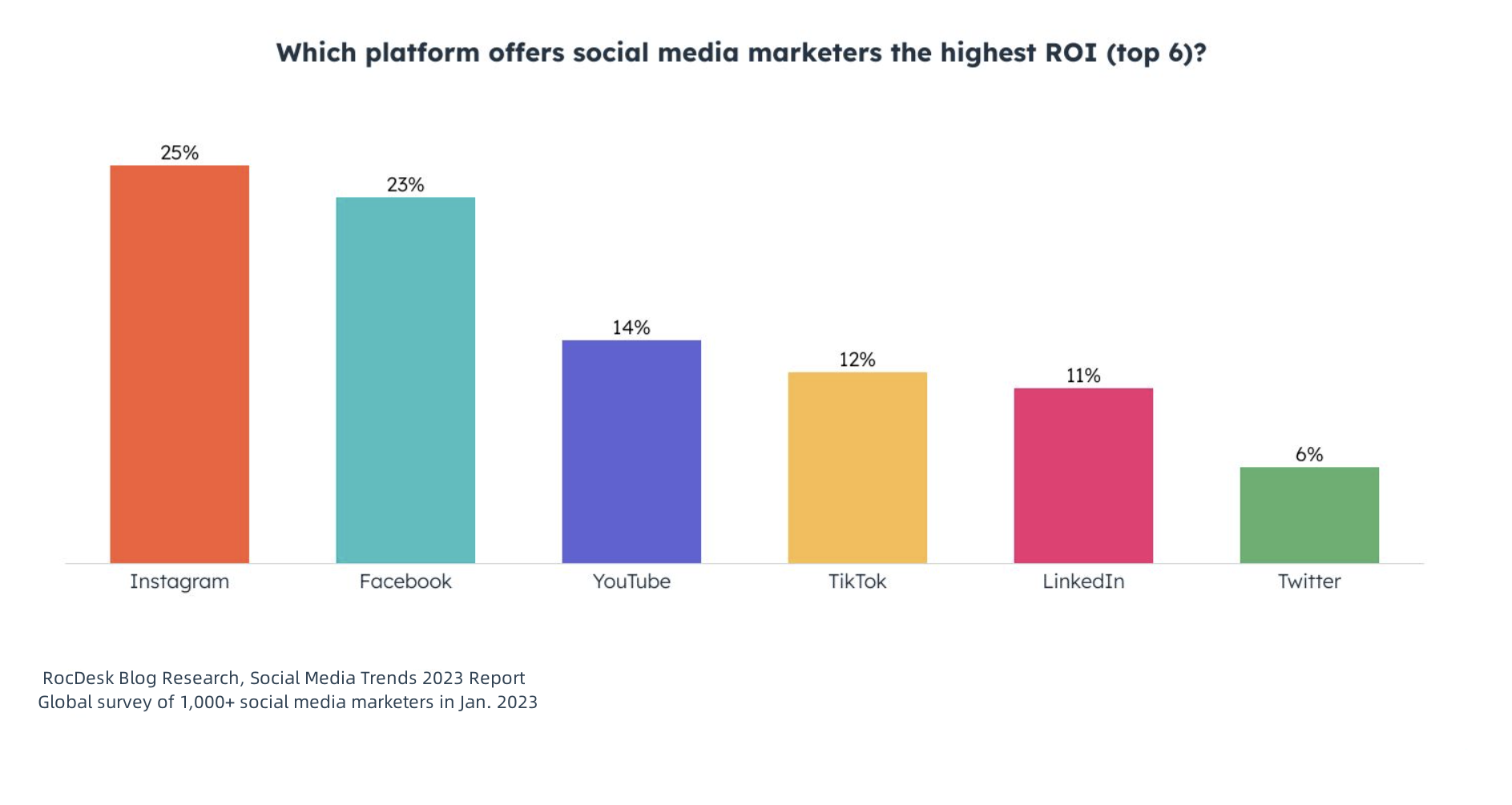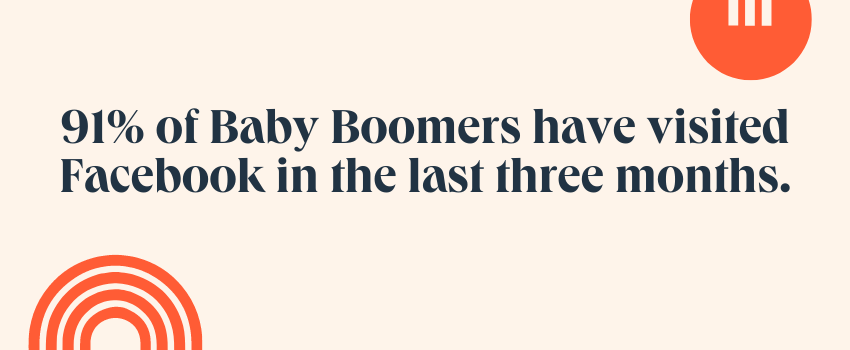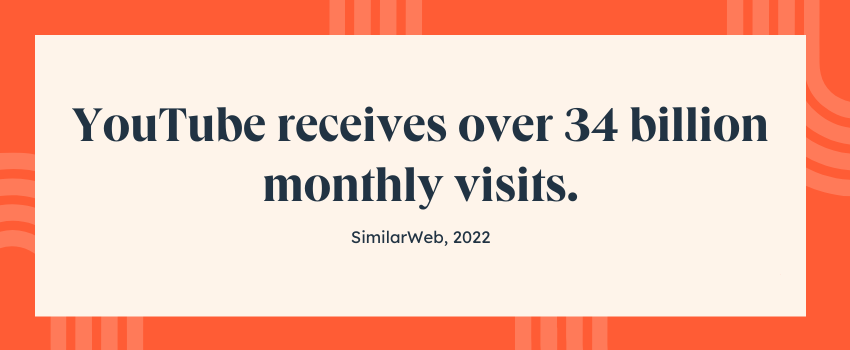These days, it feels like everyone is on social media. But make no mistake, not everyone is on every channel.

As marketers, it's important to know your audience's favorite social channels. For instance, if you're selling retirement homes, it's safe to forgo Snapchat, where only 3.7% of users are over 50.
RocDesk surveyed over 1,200 marketers around the world find out which social media channels are gaining steam — and which are falling behind. Read on to discover which platforms are most popular with marketers and consumers in 2023.
Social Media Channels Gaining Steam in 2023
Instagram
According to SimilarWeb, the Instagram app has over 78 million monthly active users, making it one of the most popular apps today.
And Instagram is expected to see more growth. Our survey results show that 52% of marketers plan to increase their investment in the platform in 2023. We also found that 29% of social media marketers plan to invest the most in Instagram over any other platform.
Marketers' affinity for Instagram makes sense, considering marketers in our survey said the app yields the highest ROI and engagement compared to other social media platforms.
 Another reason for Instagram's popularity among marketers is that the platform is leading the charge in leveraging the social selling trend. Instagram has the most developed in-app selling tools of any platform. Our survey shows that 80% of marketers believe consumers will buy products via social media apps more often than from a brand's website.
Another reason for Instagram's popularity among marketers is that the platform is leading the charge in leveraging the social selling trend. Instagram has the most developed in-app selling tools of any platform. Our survey shows that 80% of marketers believe consumers will buy products via social media apps more often than from a brand's website.
Marketers aren't the only ones using the platform.
Although Gen Z visits TikTok the most, they rank Instagram as their favorite social media app — as do Millennials. Instagram is also holding steady with older audiences. In the last few months, 55% of Gen X-ers have visited Instagram, followed by more than a quarter (27%) of Baby Boomers. However, if you're targeting these audiences specifically, Facebook or YouTube could be a better option.
Instagram is also holding steady with older audiences. In the last few months, 55% of Gen X-ers have visited Instagram, followed by more than a quarter (27%) of Baby Boomers. However, if you're targeting these audiences specifically, Facebook or YouTube could be a better option.
On the marketing side, more than half of video marketers rank Instagram as the best platform for ROI, engagement, and lead generation. If you're looking to dive more into video marketing, Instagram is an attractive option.
Facebook
Right behind Instagram, Facebook is expected to see exceptional growth in 2023. According to our survey, 23% of social media marketers plan to invest more in Facebook than any other platform, and 43% plan to increase their investment.
Furthermore, 36% of social media marketers plan to use Facebook for the first time in 2023.
Facebook currently attracts 2.93 billion monthly users, more than any of its competitors. A high concentration of its audience belongs to Millennials, Gen X-ers, and Baby Boomers.
In the last three months, a whopping 91% of Baby Boomers, 88% of Millennials, and 83% of Gen X-ers have visited Facebook.
On top of that, Gen X and Baby Boomers rank Facebook as their favorite social media app and their most visited app. If you're looking to target older demographics with social media marketing, Facebook is your best bet.

That said, engagement drops significantly for Gen Z audiences.
Just 12% of Gen Z-ers say they use Facebook more than any other platform, and only 55% have visited Facebook in the past three months.
TikTok
TikTok is known as the platform for Gen Z — and the data confirms it. In fact, over half of Gen Z consumers are on TikTok. Plus, Gen Z-ers say TikTok is the platform they use most, pulling ahead of Instagram, Snapchat, and YouTube.
It doesn't stop there: TikTok is also picking up steam with other demographics. 36% of TikTok users in 2021 were between 35 and 54 years old, a 10% increase from the year before. That said, usage amongst Baby Boomers is still low, with only 7% visiting the app in the last three months.
While only 36% of social media marketers use the platform, those who are using TikTok are strengthening their investment in 2023 - more than marketers on any other platform. In fact, 53% of them will increase their investment in marketing on TikTok in 2023, and another 36% will keep investing the same amount.
It's also worth mentioning that TikTok has the highest engagement rate out of any other social platform, averaging 10.85 minutes per session. In short, TikTok's snackable content is addictive for a variety of age groups.
YouTube
YouTube has a user base of 2 billion+ people and receives over 34 billion monthly visits, according to data we pulled from SimilarWeb.
 YouTube is popular with Gen Z, Millennial, and Gen X audiences, almost in equal measure. In the last three months, 83% of Millennials have visited YouTube, followed by 81% of Gen Z, and 79% of Gen X. For Baby Boomers, YouTube is their second favorite social media app, just behind Facebook.
YouTube is popular with Gen Z, Millennial, and Gen X audiences, almost in equal measure. In the last three months, 83% of Millennials have visited YouTube, followed by 81% of Gen Z, and 79% of Gen X. For Baby Boomers, YouTube is their second favorite social media app, just behind Facebook.
YouTube was also a top favorite amongst video marketers. In fact, more than a quarter of video marketers planned to invest in YouTube than any other platform in 2022, according to HubSpot's Video Marketing Report. In addition, video marketers ranked YouTube as the second-best platform for ROI.
Social Media Channels Losing Steam in 2023
Tumblr
After numerous acquisitions and near-revivals, Tumblr has yet to recreate its early- to mid-2000s popularity. According to our report, Tumblr is most popular with Millennials, but only 11% have visited the platform in the past three months.
 Surprisingly, Gen Z has visited Tumblr at nearly the same rate (10%). In fact, a report by Quartz found that 61% of new Tumblr users in 2022 were under the age of 24. This begs an important question: is another revival around the corner?
Surprisingly, Gen Z has visited Tumblr at nearly the same rate (10%). In fact, a report by Quartz found that 61% of new Tumblr users in 2022 were under the age of 24. This begs an important question: is another revival around the corner?
While it's still too early to call, we recommend focusing on platforms that pull stronger numbers for the audience you want to target.
Twitch
Although Twitch is top dog in the live-streaming space, all major streaming platforms — including Twitch, Facebook Gaming, and YouTube Live — are seeing a drop in total hours watched this year.
In the last three months, only 15% of Millennials have visited Twitch, followed by 13% of Gen Z, and 11% of Gen X.
Decreased viewership isn't the only concern for Twitch — people are also streaming less. Year-over-year, hours streamed on the platform declined 16% from 2021 to 2022.
When is the best time to post on social media?
While social media platforms will continue to fall in and out of favor with consumers and marketers, one thing remains constant — timing is everything. No matter which platform you choose to invest in, it's critical to know the best time to post to boost your brand's visibility.
In our Social Media Marketing report, we asked over 300 social media marketers if their company used a social media schedule or calendar when posting content, 72% of marketers said yes. Tools like HubSpot can effectively help marketers craft and execute the right social media scheduling strategy; however, knowing when to post will help boost engagement.
For example, social media marketers working in Eastern Standard Time reported 6-9 p.m. as the best time to post.
On the other hand, marketers in Pacific Standard Time said 3-6 p.m. yielded the best results.
However, the best time to post depends on your audience and when they are the most active on social media. With that said, here is a quick breakdown of what marketers say is the best time to post on each platform:
Facebook: 6-9 p.m., 3-6 p.m., and 9-12 p.m.
YouTube: 6-9 p.m., 3-6 p.m., and 12-3 p.m.
Twitter: 6-9 p.m., 3-6 p.m., and 12-3 p.m.
Instagram: 6-9 p.m., 3-6 p.m., and 9-12 p.m.
LinkedIn: 6-9 p.m., 3-6 p.m., and 12-3 p.m.
TikTok: 6-9 p.m., 3-6 p.m., and 12-3 p.m.
Additionally, marketers say Friday, Saturday, and Sunday are the best days to post across social media platforms.
Back to You
One question remains: what channels are best for your social media marketing? Should you stick to mature platforms, like Facebook and YouTube, or test the waters with new platforms, like TikTok?
Ultimately, your decision should hinge on one crucial factor: your target audience. Putting your audience at the center of your social media strategy means prioritizing the platforms that will reach them most effectively.
And remember, social media marketing is all about experimenting. There's no need to commit to one platform for the rest of time — in fact, it may be useful to run side experiments on different platforms to see what results you get.








 Another reason for Instagram's popularity among marketers is that the platform is leading the charge in leveraging the social selling trend. Instagram has the most developed in-app selling tools of any platform. Our survey shows that 80% of marketers believe consumers will buy products via social media apps more often than from a brand's website.
Another reason for Instagram's popularity among marketers is that the platform is leading the charge in leveraging the social selling trend. Instagram has the most developed in-app selling tools of any platform. Our survey shows that 80% of marketers believe consumers will buy products via social media apps more often than from a brand's website. Instagram is also holding steady with older audiences. In the last few months, 55% of Gen X-ers have visited Instagram, followed by more than a quarter (27%) of Baby Boomers. However, if you're targeting these audiences specifically, Facebook or YouTube could be a better option.
Instagram is also holding steady with older audiences. In the last few months, 55% of Gen X-ers have visited Instagram, followed by more than a quarter (27%) of Baby Boomers. However, if you're targeting these audiences specifically, Facebook or YouTube could be a better option.
 YouTube is popular with Gen Z, Millennial, and Gen X audiences, almost in equal measure. In the last three months, 83% of Millennials have visited YouTube, followed by 81% of Gen Z, and 79% of Gen X. For Baby Boomers, YouTube is their second favorite social media app, just behind Facebook.
YouTube is popular with Gen Z, Millennial, and Gen X audiences, almost in equal measure. In the last three months, 83% of Millennials have visited YouTube, followed by 81% of Gen Z, and 79% of Gen X. For Baby Boomers, YouTube is their second favorite social media app, just behind Facebook. Surprisingly, Gen Z has visited Tumblr at nearly the same rate (10%). In fact, a report by Quartz found that 61% of new Tumblr users in 2022 were under the age of 24. This begs an important question: is another revival around the corner?
Surprisingly, Gen Z has visited Tumblr at nearly the same rate (10%). In fact, a report by Quartz found that 61% of new Tumblr users in 2022 were under the age of 24. This begs an important question: is another revival around the corner?


